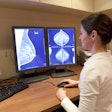Pairing breast cancer screening with lung cancer screening could boost screening uptake for the latter, according to research published June 10 in the Journal of Surgical Research.
A team led by Tiffany Yue from Stanford University found that, despite limited prescreening knowledge among women about lung cancer screening eligibility and cost, most women in the study expressed support for dual screening.
“Pairing breast and lung cancer screening is a feasible, acceptable intervention that, along with increasing patient and provider education about lung cancer screening, can increase lung cancer screening uptake and reduce lung cancer mortality,” the Yue team wrote.
While many U.S. women undergo routine mammography for breast cancer screening, lung cancer screening uptake is low, according to a National Cancer Institute report. The researchers suggested that screening mammography can be a “teachable moment” to increase lung cancer screening uptake among dual-eligible women. They also pointed out that attitudes toward combined cancer screening are not well understood.
Yue and colleagues implemented a multi-institutional dual cancer screening program pairing breast and lung screening together. For their study, they described the results of qualitative surveys administered to women as they underwent the program. This included assessing women’s perceptions, knowledge, and attitudes about lung cancer and screening before and after dual screening. The study also evaluated the feasibility and acceptability of this type of program.
The study included survey data collected in 2022 and 2023 from 54 women who were eligible for lung cancer screening. Of the total cohort, 81% were white, the median age was 57 years, and the median pack years of smoking was 36. The women were also referred to the respective thoracic surgery or pulmonary cancer screening clinic for a shared decision-making visit.
The team reported the following:
- 98% of women felt they were at risk for lung cancer, with 80% reporting being motivated by early detection of potential cancer.
- 58% of women said they lacked knowledge about lung cancer screening eligibility, and 47% reported concerns about screening cost.
- Prior to undergoing lung cancer screening, 87% of women expressed interest in combined breast and lung screening.
- After lung cancer screening, 84% of women said they were likely or very likely to undergo dual screening again, and 93% found the shared decision-making visit helpful or very helpful.
The study authors highlighted that the dual screening program has “strong buy-in” from institutional stakeholders and screening participants. They added that the results show acceptability, adoption, feasibility, and fidelity.
“We found clear interest and willingness to undergo lung cancer screening in our target population of at-risk women and an equal desire to do so as part of a dual cancer screening program,” the authors wrote.
The Yue team added that future work will focus on improving patient knowledge around lung cancer screening and promoting successful, sustainable implementation of dual cancer screening programs.
The full results can be accessed here.



















